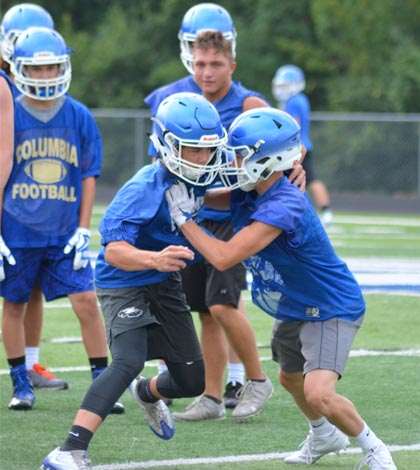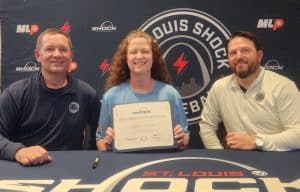Tackling concussions is total team effort

Pictured, Columbia High School football players practice last week. The season begins Aug. 25. (Corey Saathoff photo)
With another high school sports season set to begin, student-athlete safety is of chief concern to coaches, administrators and athletic trainers.
Concussions have received the most attention over the past few years, including a policy implemented in all Illinois schools that puts the emphasis on training all those in positions of authority.
Under this policy, all coaches, school nurses, athletic trainers, band directors, and game officials are required to complete concussion training. All high school coaching staff and athletic directors must obtain online concussion certification every other year.
All student-athletes must watch a video about concussions and are required to receive a baseline test before participating in any sport. A student-athlete who exhibits symptoms consistent with a concussion in a practice or game will be removed from participation immediately.
Most local high school athletic programs had already put a system in place to deal with concussions prior to the state guidelines.
“Concussions are tough to find trends,” said James Sepich, who serves as the athletic trainer for Columbia High School on behalf of ATI Physical Therapy. “Most are a result of accidents and those are unpredictable.”
Sepich said he dealt with a total of 21 concussion-related incidents from Aug. 1, 2016 to July 31, 2017.
“All of those didn’t occur in CHS athletics, but since they were CHS athletes I worked them through the return to play,” Sepich explained.
These concussions may have occurred in club sports, physical education, or CHS athletics.
While football is the sport most commonly associated with concussions, Sepich said there were a handful that came from each sport throughout the year.
Sepich said the CHS football program has installed technology in each players’ helmet that helps determine hits that are between 95 to 99 percent of those studies have shown to cause a concussion.
“This tool is just that, a tool,” Sepich explained. “Every concussion will not produce an alert and every alert will not produce a concussion. It is a tool that is used to help me as an athletic trainer have a conversation with someone that may be hurt.”
Sepich added that new technology this year now allows him to track a player’s “sub-alert” hits and monitor those athletes who may need to change their tackling form based on helmet activity.
“(CHS head football coach Scott Hoerner) and I will be meeting each week to discuss these trends in hopes to fine tune practice plans to make the game as safe as possible for every athlete on the field,” Sepich said.
The helmet sensors were made possible thanks to the Columbia Quarterback Club, which conducted various events to raise funds for this contribution to the program.
“Basically every kid in the CHS football program is now equipped with them,” Columbia Quarterback Club President Ron Hunsaker said. “The purpose of our club is to enhance the football experience at CHS. This idea fell right in line with that.”
Anna Casaleggi, who serves as the athletic trainer for Waterloo High School on behalf of ATI Physical Therapy, said the recent policy changes in Illinois on concussions have been instrumental in creating a team of those caring for the student-athlete.
Casaleggi said she saw 15 WHS students last year for concussions, but only six of those occurred during WHS sporting events.
“The rest were students who sustained a concussion usually by a motor vehicle accident or sports outside of school,” she said.
Casaleggi said it is important to support students in this matter, as concussions can be tricky to recover from.
“I tell my students that coming back from a concussion is sometimes just as hard as coming back from a muscular injury in the fact that you have to slowly build back up and re-train how things work,” she said.
The new policies have taken this into consideration, Casaleggi said, and help teachers understand that students may operate on different concussion recovery schedules.
“This can be a frustrating process, as they seem and act normal so those around them may not remember that they are coming back from a brain injury,” Casaleggi said.
Basically, the more education students, parents, faculty, and teachers at schools, can have about concussions and the policies at their schools the better.
“There is still much research to be done in this field, but as more knowledge is available we need to be receptive to that and adjust to follow best practices,” Casaleggi said.






